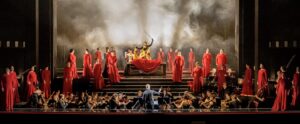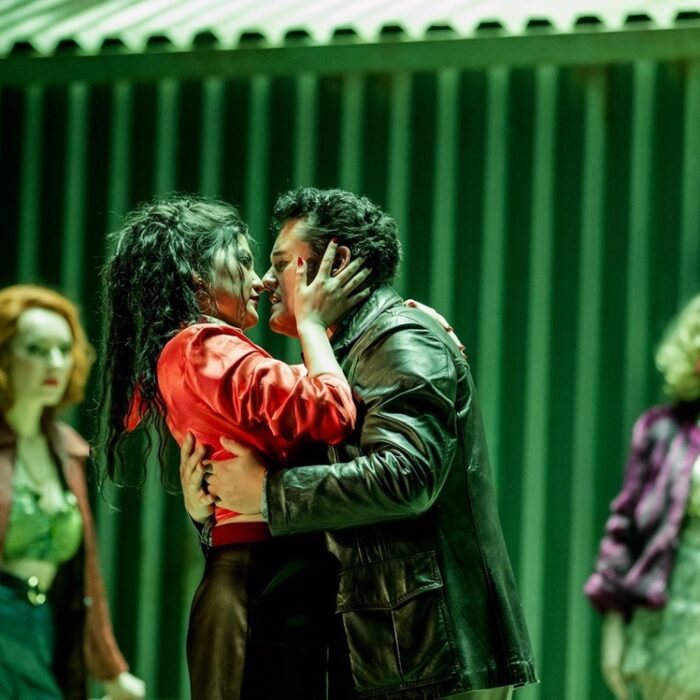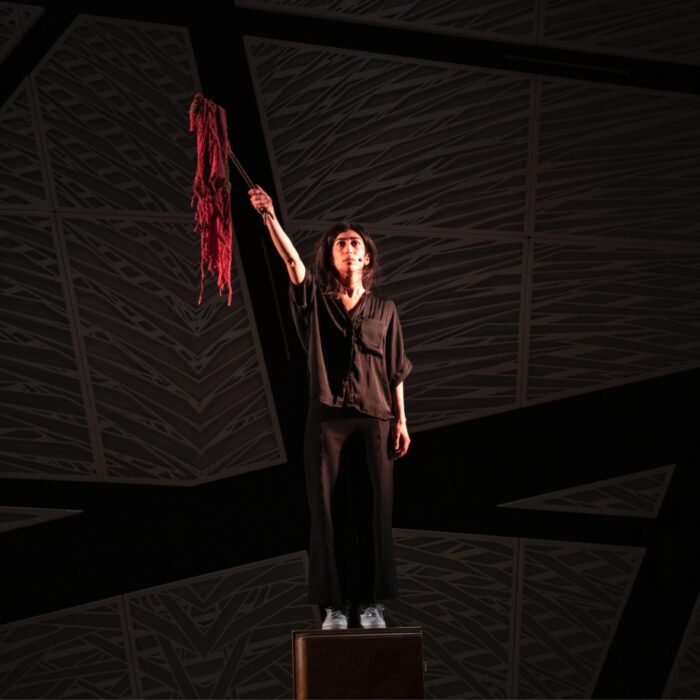
Innsbruck Early Music Festival 2023 Review: Juditha Triumphans
De Marchi Signs off His Tenure as Artistic Director in Style
By Alan Neilson(Photo: Birgit Gufler)
At the final curtain call of the Innsbruck Early Music Festival’s splendid production of Vivaldi’s only surviving oratorio, “Judtha Triumphans,” the loudest acclamation was reserved for its conductor, Alessandro De Marchi. After 13 years as its artistic director, he is stepping down from the position. The genuine warmth the festival audience showed towards De Marchi was clearly shared by the cast and orchestra, who joined enthusiastically in applause. Since taking up the role in 2010, he has overseen many excellent staged and semi-staged opera productions, concerts, recitals and oratorios for which he will be fondly remembered. He has also introduced numerous innovations, including the now internationally renowned Cesti competition for singers of baroque music and the “Barokoper Jung” productions, which are performed by the young singers from past Cesti competitions.
Fittingly, the cast, production team and orchestra marked the occasion with a production that could only be described as a triumph.
Written in 1716 to a libretto by Giacomo Cassetti, the work is a celebratory piece to commemorate Venice’s victories over the Ottoman Turks and was premiered at Venice’s Chiesa della Pietà in the same year. As a result of Vivaldi’s position at the Ospedale della Pietà, where he taught music to orphaned girls, the five parts for solo performers were written for the female voice. Each part represents a major protagonist in the conflict. Venice was represented by the heroine Juditha and the Sultan by Holofernes, while Abra stands for the Christian faith, Ozia for the pope and Vagaus represents a Turkish general.
Unlike the majority of oratorios, “Juditha Triumphans” does not feature a narrator. Instead, the drama unfolds through the actions of the characters and thus has a similar dramatic structure and dynamic to an opera. It is a fast-moving and gripping drama focused on war, bravery, murder and seduction. At its center is Judith’s decapitation of Holofernes, whom she has enticed into lowering his guard with wine and the promise of love. It has thus been termed an “oratorio erotico,” and its similarity to “Salome” is immediately obvious. It is, therefore, equally suited to the stage as much as it is to the concert hall. Director Elena Barbalich proved to be dramatically strong, although, in certain respects, often understated in presentation.
Barbalich’s Dramatically Secure & Stylish Presentation
The singers, while interacting strongly with each other and having their emotions clearly etched in their voices, often restrained their physical movements so that they had a stylized quality. Barbalich used a platform erected in front of the orchestra that allowed the singers to sing directly to the audience. The prominence of instrumental solo parts were often positioned standing on one side of the stage, alongside other seated musicians. This gave the production a more balanced and integrated quality than may have otherwise been the case.
Massimo Checchetto’s stage designs were divided into two distinct parts. In Part one, the stage was basically an empty space in which Fabio Barettin’s sensitive lighting, consisting of mainly dark blue, red and black colors, was used to highlight mist that billowed across the stage. This created a colorful flux of changing atmospheres. Narrow white beams shining down vertically from above or horizontally across the stage added another abstract dimension. It was wonderfully successful, to the extent that when a few stools were brought on towards the end of the first part, it slightly disrupted the effect.
Part two opened to a colorful scene consisting of a single long table adorned with bowls of fruit, around which sat women in stunning bright costumes. This morphed easily into a bed on which Holofernes slept, where Juditha cut off his head. Then into the final scene in which she stood sword in hand, above Holofernes decapitated corpse, on a raked platform with the chorus positioned across the stage in what was a visually breathtaking tableau.
The effect was, in no small part, down to Tommaso Lagattolla’s brightly colored costumes. Although not of the period or of any one period, they were sympathetically imagined to create a coherent aesthetic that fitted sensitively to meet the needs of the drama. The chorus was costumed in long, mainly red dresses. The principals were all in different, mostly single-colored costumes of varying designs.
The production was also a testimony to Barbalich’s skill in managing large numbers of people in a tight space without compromising the dramatic intensity, intimacy or clarity. She had to deal with not just five principals and a chorus but also an orchestra that took up space on both the left and right sides of the stage. The members would occasionally walk on and off the set or stand up to accompany a soloist. The fact that she was able to achieve this while maintaining dramatic coherence and verisimilitude was impressive.
Rennert’s Compelling Layered Characterization
Juditha is a complex character requiring a high level of interpretative ability. Fortunately, in mezzo-soprano Sophie Rennert, the Innsbruck Early Music Festival had an ideal singer. She maintained Juditha’s dignity and sense of piety while simultaneously seducing and then cutting off Holofernes’ head. She appeared brave and steadfast and be able to portray the pretense of love while feeling disgust. She is plunged into dangerous and emotionally extreme situations and must be able to voice the depth of her feelings in both recitatives and arias. Her tasks demand a clear insight into the character along with excellent vocal skills. Rennert had both.
Her recitatives were expertly fashioned and full of meaning. They were clearly articulated and possessed emotional strength. Her arias careered through a range of emotions, with which she was sensitively and fully engaged. In her opening aria, “Quocum Patriae me ducitamore,” she showed off her sensitive phrasing, delicate coloratura, subtle alterations in coloring and gentle embellishments. In “Agitata infido flatu,” she displayed a more explosive quality, pushing the voice upward and indulging in passionate passages of coloratura in which her fine vocal control was never compromised. In her final aria of seven, “In sono profundo,” she cut a fine figure with her sword in her outstretched hand as she readied to kill the sleeping Holofernes. Sophie Rennert beautifully captured the bravery and determination of Juditha.
Mezzo-soprano Anastasia Boldyreva created a very strong impression of Holofernes, whom she characterized as vicious, demanding and despotic. Even her attempted seduction of Juditha appeared more like a predator stalking its prey than someone charmed by love’s delights. Her gestures were strong and assertive. Her facial expressions were sharp, cruel and aggressive. Her make-up deliberately sharpened her features, and her costume was a futuristic military style. Her singing was defined by the vicious curl with which she was able to imbue her voice. Her seduction aria, “Nos obscura tenebrosa,” was brilliantly rendered to capture the intent behind her honied words. Superficially, it was beautifully sung with a romantic lilt. But, underlying her dark and alluring tones was the subtle sound of aggression and malice.
Soprano Arianna Vendittelli, playing the role of Holofernes’ servant Vagaus, was suitably loyal. Although the role has four strong arias with plenty of passages of coloratura and embellishments to show off the voice, it is the bravura aria “Armate di fuoco e di serpi,” which Vagaus sings on discovering Holofernes’ decapitated body. This really defines the performance. The audience sat entranced as Vendittelli unleashed a series of complex passages of coloratura and ornate embellishments. She took prodigious leaps in her stride and pushed the voice towards its limit, at the end of which she received loud cheers and sustained applause.
One almost felt sorry for mezzo-soprano Emilie Renard. In the role of Abra, she has little to do other than support Juditha in the most subservient manner, praising her every move and her every utterance. Fortunately, Vivaldi provided her with four arias, which allowed her to show off certain aspects of her voice, notably the delicacy and sensitivity of her phrasing and her ability to imbue the vocal line with gentle embellishments. The most interesting of her arias was “Fulgeat sol frontis decorae,” in which she is at least able to exert some light pressure on Juditha by encouraging her to go through with her plan.
Mezzo-soprano Lorrie Garcia captured the attention of the audience with her wonderfully colored palette, in which she spun out lines in a variety of dark combinations. As the High Priest Ozias, she sang with suitable authority and strength. The only slight criticism was that in her final aria, “Gaude felix,” in which she calls upon the city of Bethulia to rejoice, her coloratura passages could have been delivered with more lightness and a greater sense of joy.
The Coro Maghini, directed by Claudio Chiavazza, had plenty to do, both as actors and singers. Dressed in long, mainly red dresses, the all-female chorus was required to take up static poses and sing from along the sides of the auditorium. They moved around the stage, and cross the platform in front of the orchestra, as well as engage in active choreographed scenes. Their singing throughout the evening was excellent.
Maestro Alessandro De Marchi appeared to be enjoying every moment of his final staged production as artistic director. He produced a wonderfully sensitive reading from the Innsbrucker Festwochenorchester, in which he brought out the full beauty of Vivaldi’s score. The orchestra created a sound full of rhythmic vitality and clear textures, underpinned by a pleasing forward momentum. He created the necessary space for the numerous individual performances to shine and ensured that the orchestral sections were nicely balanced and the singers received the necessary support. Most importantly, he captured the spirit of Vivaldi’s melodies.
Having seen “Juditha Triumphans” on a number of occasions, both as concert and fully staged performances, this has to be the best so far. It was visually and musically stunning. “Juditha Triumphans” brings to a fitting end De Marchi’s staged productions as artistic director of the Innsbruck Early Music Festival.



